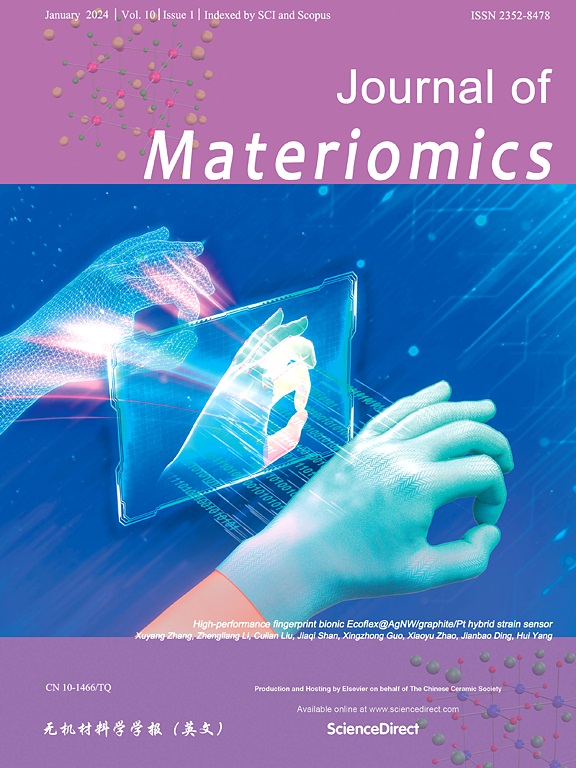通过微结构纹理工程实现基于 BaTiO3 的压电多层致动器中的超低应变滞后
IF 9.6
1区 材料科学
Q1 CHEMISTRY, PHYSICAL
引用次数: 0
摘要
与块状陶瓷致动器相比,压电多层致动器(MLA)具有驱动电压更低、结构更紧凑的独特优势。然而,压电多层致动器的内部电极层不可避免地会削弱输出,导致应变相对较低。压电陶瓷的滞后特性也极大地限制了 MLA 的定位精度。在这项工作中,我们在基于 BaTiO3 的 MLA 中采用了晶体纹理和畴工程的协同策略,通过提高压电性来增强应变,同时抑制超低磁滞。我们通过模板晶粒生长(TGG)方法在 MLA 中制备了[001]c 取向(Ba0.95Ca0.05)(Ti0.94Zr0.055Sn0.005)O3(BCTZS)陶瓷层,其纹理度达到 95%。纹理化 BCTZS MLA 在 200 V 下具有 196 nm 的大位移(是随机取向 MLA 的 2.4 倍),并实现了超低应变滞后(Hs<9%)。在 200 V 极化前后,纹理 MLA 的位移和应变滞后几乎相同,这表明在各种电压条件下,定位的可重复性更好。这一发现可归因于更容易的畴切换,因为纹理晶粒中的高纹理度和占主导地位的 "4O "畴构型可容纳箝位应力,这降低了畴壁能量,但增加了畴的柔性。本文章由计算机程序翻译,如有差异,请以英文原文为准。

Ultra-low strain hysteresis in BaTiO3-based piezoelectric multilayer actuators via microstructural texture engineering
Piezoelectric multilayer actuators (MLAs) possess unique advantages of lower driving voltages and more compact structures than bulk ceramic actuators. However, the internal electrode layers in MLAs inevitably weaken the output and result in relatively lower strain. The hysteresis property of piezoelectric ceramics also significantly limits the positioning accuracy of MLAs. In this work, we adopted a synergistic strategy of crystallographic texturing and domain engineering in BaTiO3-based MLAs to enhance strains by improving piezoelectricity while simultaneously restraining the ultra-low hysteresis. We prepared [001]c-oriented (Ba0.95Ca0.05)(Ti0.94Zr0.055Sn0.005)O3 (BCTZS) ceramic layers in MLAs through the template grain growth (TGG) method with a texture degree of ∼95%. The textured BCTZS MLAs had a large displacement of 196 nm at 200 V (∼2.4 times that of randomly oriented ones) and achieved ultra-low strain hysteresis (Hs<9%). These almost identical displacement and strain hysteresis in textured MLAs before and after polarization at 200 V indicated better positioning repeatability under various voltage experiences. This finding can be attributed to easier domain switchings, because the high texture degree and the dominant “4O” domain configurations in textured grains accommodated the clamping stress, which decreased the domain wall energy but increased the domain flexibility.
求助全文
通过发布文献求助,成功后即可免费获取论文全文。
去求助
来源期刊

Journal of Materiomics
Materials Science-Metals and Alloys
CiteScore
14.30
自引率
6.40%
发文量
331
审稿时长
37 days
期刊介绍:
The Journal of Materiomics is a peer-reviewed open-access journal that aims to serve as a forum for the continuous dissemination of research within the field of materials science. It particularly emphasizes systematic studies on the relationships between composition, processing, structure, property, and performance of advanced materials. The journal is supported by the Chinese Ceramic Society and is indexed in SCIE and Scopus. It is commonly referred to as J Materiomics.
 求助内容:
求助内容: 应助结果提醒方式:
应助结果提醒方式:


